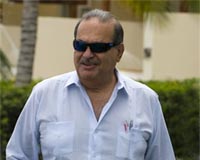 |
West Lafayette IN (SPX) Jun 09, 2009 Researchers have used Bluetooth signals from cell phones and other wireless devices to track how long it takes travelers to get through security lines at the Indianapolis International Airport. The research expands previous work that has focused on measuring motor-vehicle travel times and could lead to systems that help reduce waits at airport security checkpoints, said Darcy Bullock, a professor of civil engineering at Purdue University. "This is the first time anyone has tracked Bluetooth signals to measure how long it takes travelers to get through security lines in the United States," he said. "We expect the data can be used to help airports make more accurate staffing decisions and aid security officials comparing wait times at airports across the country." Bluetooth technology exchanges information for cell phone hands-free headsets, wireless keyboards, Internet access for personal digital assistants, and wireless networks for laptops and personal computers. The wait time estimation procedure detects and records "media access control" identification signals, or addresses, each time a Bluetooth device passes a detector. The researchers used two electronic readers - one at the beginning and one at the end of the security lobby - to record signals from portable devices carried by ticketed passengers. "This technique is more efficient than conventional methods and easier to implement because it automatically calculates waiting time," said Robert Spitler, director of security at Indianapolis International Airport. The addresses consist of a string of numbers and other characters, but only a portion of each address was recorded to track people, preserving the privacy of travelers. "It's kind of like writing down only part of someone's license plate," Bullock said. "You can't identify people by tracking only a portion of their addresses." The data showed security wait times peaked at 20 minutes during the heaviest passenger processing times in Indianapolis, which occurred around 6 a.m. Wait times diminished rapidly after 6:30 a.m. and leveled off for the rest of the day at about six minutes per passenger. "What we are really interested in is what is the worst-case scenario and how long does it take somebody to get through security," Bullock said. "What we saw in Indianapolis is that it really never takes anybody longer than 20 minutes. Most of the time, it's less than 10 minutes." Researchers used the system from May 8 to June 1 to observe the impact of increased passenger traffic associated with the Indianapolis 500, Bullock said. The number of passengers passing through Concourse B screening on Monday, May 18, was typical at 7,549. However, on Monday, May 25, the passengers passing through Concourse B totaled 10,568, an increase of about 40 percent. Despite this surge in passengers, the Bluetooth travel-time monitoring showed that screening wait times remained less than 15 minutes throughout the day, Bullock said. "We are fortunate in Indianapolis because we have a new terminal with spacious security checkpoint areas and multiple processing lanes, so passengers are able to clear security relatively quickly and make their way to the gate," Spitler said. "But from a technology standpoint, this Bluetooth system is an intriguing tool because it has the potential to provide continuous, real-time wait information at our fingertips. We have been debugging the process, and if it develops into a formal product that continues to work well, we might pursue using it in Indianapolis on a daily basis." The system could be especially helpful for more congested airports and to manage unexpected surges of airline customers. "This is a prototype, but I think the system could be put in every airport in the country," Bullock said. "As a traveler, I would love to know if one line is moving faster than another line or if I arrive at 6 a.m. I am going to have a 20-minute line, but if I arrive at 9 a.m., I only have to plan for a five-minute wait." The researchers have used the same technology to measure motor vehicle travel time, and the Indiana Deparent of Transportation uses it to monitor traffic on Interstate 65 south of Chicago, where construction frequently causes backups. Motorists are alerted to delays on large electronic signs, providing an opportunity to exit the highway to take alternative routes. "If you know what the delay is, you as a motorist or airline passenger can make an informed decision," Bullock said. Future work may involve additional airport studies and may be expanded to additional sections of highway, Bullock said. "This approach represents a treasure trove of valuable traffic information for monitoring travel time across a variety of transportation modes," he said. "The demand for this type of data is rapidly increasing, and small businesses are starting to enter this market. In fact, we used one of the commercial devices produced by Traffax Inc. for part of this study." Share This Article With Planet Earth
Related Links Purdue University
 Billionaire Slim looks to future jobs with green investment
Billionaire Slim looks to future jobs with green investmentCozumel, Mexico (AFP) June 4, 2009 Mexican billionaire Carlos Slim, one of the world's richest men, on Thursday launched a joint 100 million dollar project which includes the largest ever private investment in Mexico's environment. "I believe that looking after the environment will be one of the big generators of jobs in the future," said Slim, who will provide half the funding in the project with the Mexican government and ... read more |
|
| The content herein, unless otherwise known to be public domain, are Copyright 1995-2009 - SpaceDaily. AFP and UPI Wire Stories are copyright Agence France-Presse and United Press International. ESA Portal Reports are copyright European Space Agency. All NASA sourced material is public domain. Additional copyrights may apply in whole or part to other bona fide parties. Advertising does not imply endorsement,agreement or approval of any opinions, statements or information provided by SpaceDaily on any Web page published or hosted by SpaceDaily. Privacy Statement |